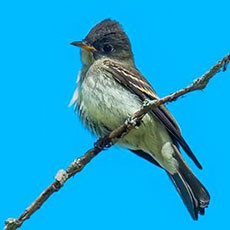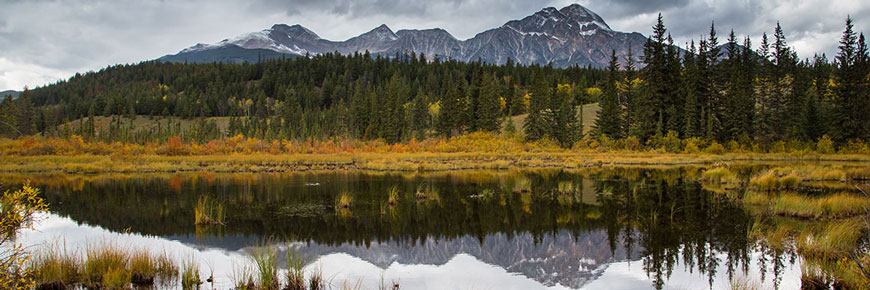
Olive-sided flycatcher
Jasper National Park
Quick facts
Eats large flying insects - mostly bees, wasps and flying ants
Hunts as a “sit-and-wait” predator, perching on a branch until they spot prey
Lays three eggs per year
Whistle sounds like "Quick, three beers!"
SARA status: Threatened (2010)
COSEWIC recommended status: Special Concern (2018)

Olive-sided flycatchers (Contopus cooperi) are medium-sized songbirds. They are recognized for their loud, three-note whistle. This olive-coloured bird with a white underbelly is most often seen perched on the top of tall trees. Olive-sided flycatchers arrive in Canada in the spring to breed and lay two to five eggs. They then return south at the end of summer.
Where they live
Olive-sided flycatchers migrate long distances. They fly over 8 000 kilometres from their summer grounds in Canada to winter in the Andes Mountains of South America. This makes them vulnerable to threats along their routes.
Olive-sided flycatchers prefer habitats like forest openings, where they perch in tall or dead trees and dart off to hunt insects. Look for olive-sided flycatchers near avalanche paths or old burnt forests. In Jasper National Park, they have been heard near sloughs in the valley bottom and up to the subalpine at Mount Edith Cavell.

Why they are at risk
Migratory birds that eat flying insects have significantly declined around the world since the 1970s. The cause of this decline is likely the combined effects of many factors, including declining insect populations, habitat loss, and climate change.
The Committee on the Status of Endangered Wildlife in Canada has recommended the olive-sided flycatcher be listed as a species of Special Concern because the rate of decline has slowed and the species appears to have stabilized in areas with good habitat.
Flying insect declines
The global decline in flying insects is not well understood. Some possible reasons include: 1) the use of pesticides – which are chemicals used to control weeds, insects and fungus, 2) methods used to boost agricultural production that affect soil and water sources, 3) extreme weather events, 4) destruction of wetlands and 5) the warming climate. Less bugs means less food for migratory birds.
Human development and activity
For decades, humans have put out wildfires, causing open grasslands to become overgrown and forested.
Habitat loss due to deforestation, fire suppression and other human activities is likely the greatest threat to olive-sided flycatchers, especially loss of their winter habitat in South America and anywhere along their migratory routes.
Climate change
Climate change may affect the olive-sided flycatcher, its habitat and its migration routes in many ways. Changes to the patterns and severity of extreme weather events like fires, droughts and hurricanes all have the potential to impact the olive-sided flycatcher and the availability of its insect prey.
How we are helping
Restoring fire
We use prescribed fires to open up the forest near areas with water in order to provide more nesting habitat.
Monitoring
General bird population monitoring in the park shows a stable population from 2007–2016.
We monitor the bird sighting database at ebird.org. Share your sightings to contribute to this citizen science project.

Restoring grasslands with prescribed fire in the Athabasca Valley in 2021.
- Date modified :